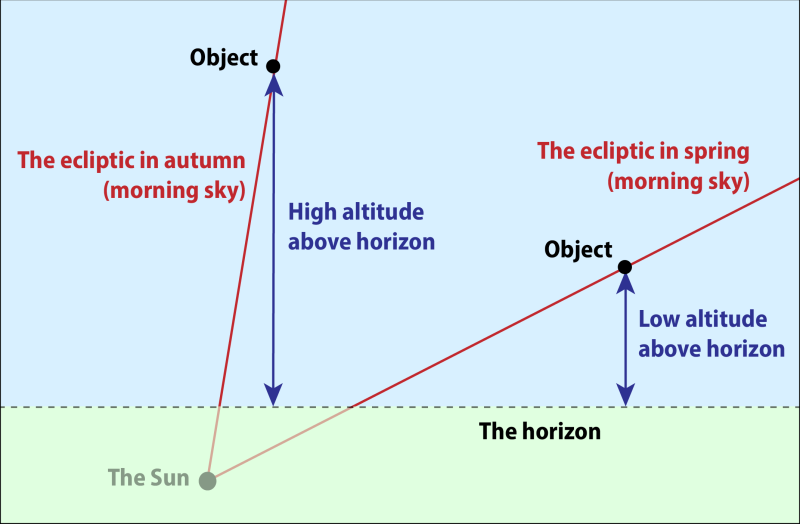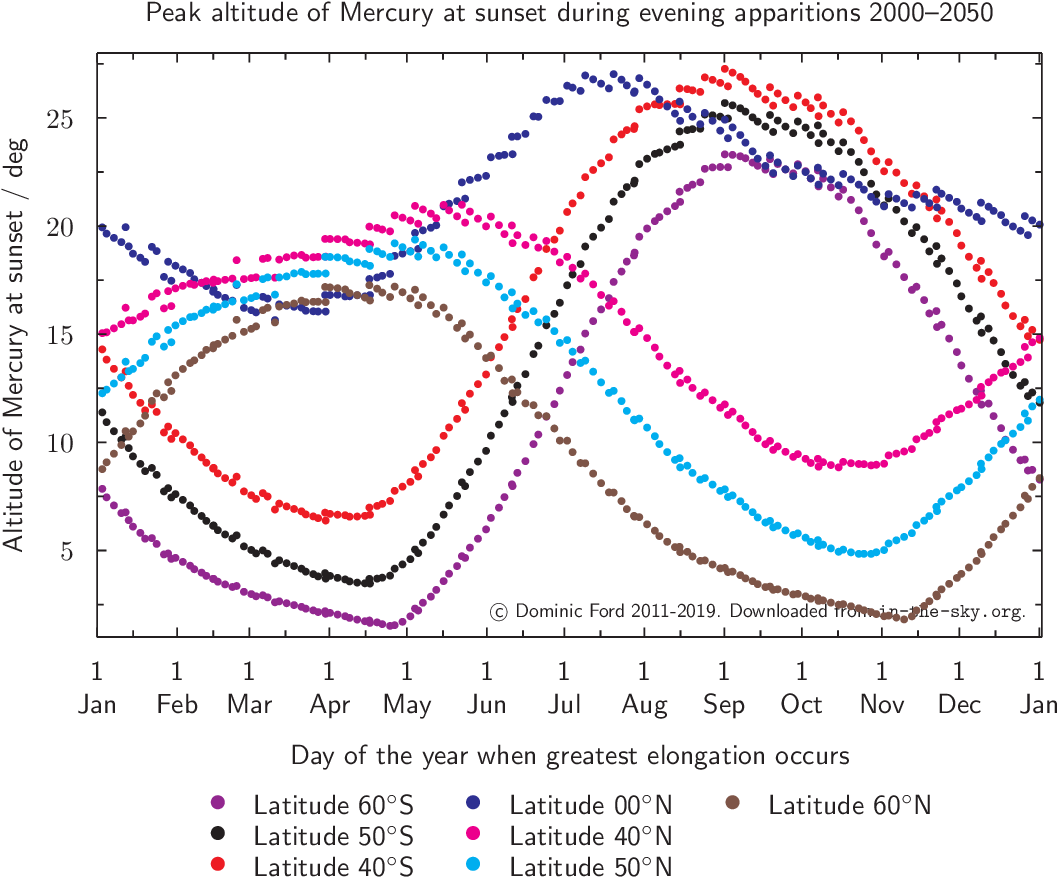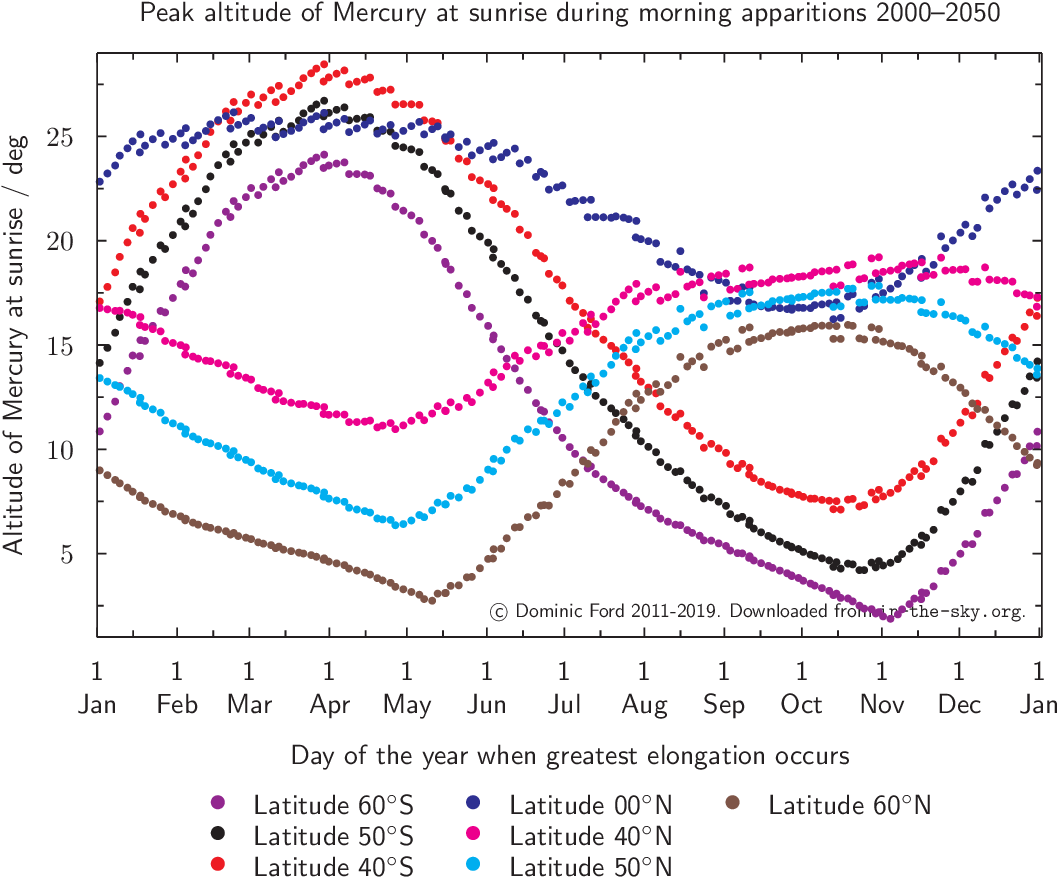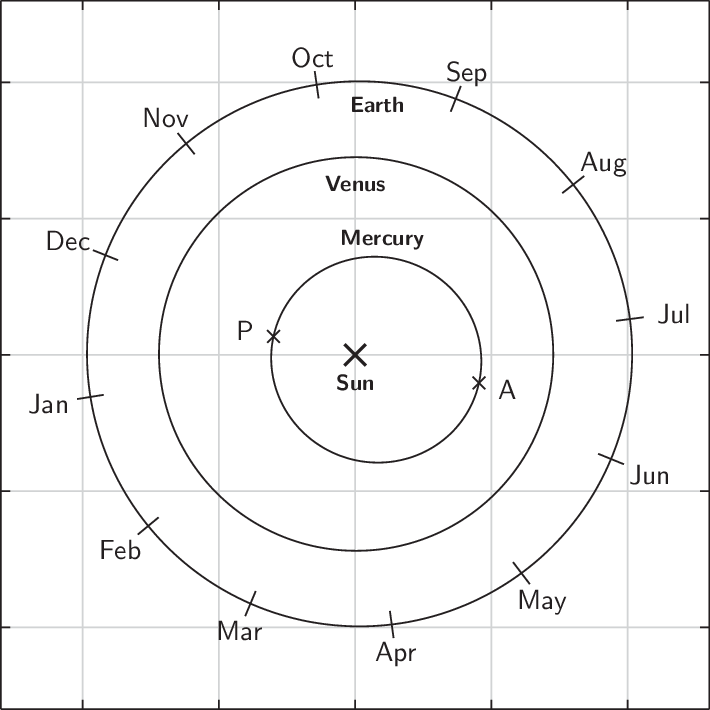Mercury
The planets of the solar system:
Mercury
Venus
Earth
Mars
Jupiter
Saturn
Uranus
Neptune
Mercury will soon pass in front of the Sun at inferior solar conjunction. From South El Monte, it is not observable – it will reach its highest point in the sky during daytime and is no higher than 7° above the horizon at dawn.
| 07 Dec 2025 | – Mercury at greatest elongation west |
| 19 Feb 2026 | – Mercury at greatest elongation east |
| 20 Feb 2026 | – Mercury at highest altitude in evening sky |
| 29 Mar 2026 | – Mercury at highest altitude in morning sky |
Mercury, as seen by NASA's MESSENGER spacecraft.
Mercury is the innermost planet in the solar system, orbiting the Sun at a distance of 0.387 AU once every 88 days.
At its brightest, it can reach magnitude -1.9, a little brighter than Sirius, the brightest star in the sky. However, it more normally hovers at around magnitude 0, becoming roughly the fifth brightest object in the sky.
Nonetheless, it is always a challenging object to observe because it never ventures far from the Sun – at most 28.3°. This means it must always be observed in twilight, either at dusk or dawn. Additionally, because it is always close to the horizon at these times, it must always be observed through thick layers of the atmosphere where seeing conditions are poor.
Apparitions of Mercury
The table below lists apparitions of Mercury around the year 2025, computed from NASA's DE430 planetary ephemeris. To show events around other years, use the control below.
Apparitions of Mercury around 2025
| Date | Event | Declination | Angular size |
| Date | Event | Declination | Angular size |
| 21 Jul 2024 20:37 PDT | Mercury at greatest elongation east | 11°51'N | 7.8" |
| 04 Sep 2024 19:24 PDT | Mercury at greatest elongation west | 13°20'N | 7.2" |
| 16 Nov 2024 01:18 PST | Mercury at greatest elongation east | 25°22'S | 6.6" |
| 24 Dec 2024 23:10 PST | Mercury at greatest elongation west | 20°09'S | 6.6" |
| 07 Mar 2025 17:41 PST | Mercury at greatest elongation east | 3°53'N | 7.3" |
| 21 Apr 2025 08:06 PDT | Mercury at greatest elongation west | 0°38'S | 7.9" |
| 03 Jul 2025 21:37 PDT | Mercury at greatest elongation east | 18°14'N | 8.1" |
| 19 Aug 2025 05:25 PDT | Mercury at greatest elongation west | 17°29'N | 7.4" |
| 29 Oct 2025 13:28 PDT | Mercury at greatest elongation east | 22°56'S | 6.6" |
| 07 Dec 2025 16:14 PST | Mercury at greatest elongation west | 16°48'S | 6.6" |
| 19 Feb 2026 06:35 PST | Mercury at greatest elongation east | 3°25'S | 7.1" |
| 03 Apr 2026 11:48 PDT | Mercury at greatest elongation west | 7°08'S | 7.6" |
| 15 Jun 2026 15:40 PDT | Mercury at greatest elongation east | 23°04'N | 8.2" |
Observing Mercury
Mercury is observable for a few months each time it reaches greatest separation from the Sun – moments referred to as greatest elongation. These apparitions repeat roughly once every 3–4 months, taking place alternately in the morning and evening skies, depending whether Mercury lies to the east of the Sun or to the west.
When it lies to the east, it rises and sets a short time after the Sun and is visible in early evening twilight. When it lies to the west of the Sun, it rises and sets a short time before the Sun and is visible shortly before sunrise.
However, some times of the year are more favourable for viewing Mercury than others. From South El Monte, it reaches a peak altitude of between 11° and 22° above the horizon at sunset during each evening apparition, depending on the time of year. During morning apparitions, it reaches a peak altitude of between 14° and 20° at sunrise.
This variability over the course of the year is due to a combination of two factors.
The inclination of the ecliptic to the horizon
At all times, Mercury lies close to a line across the sky called the ecliptic. This line traces the path that the Sun takes through the zodiacal constellations every year, and shows the plane of the Earth's orbit around the Sun. Since all the planets circle the Sun in almost exactly the same plane, it also closely follows the planes of the orbits of the other planets, too.
When Mercury is widely separated from the Sun, it is separated from it along the line of the ecliptic. But, at different times of year, the ecliptic meets the horizon at different angles at sunset and sunrise. This would translate into Mercury being at different altitudes above the horizon, even if its separation from the Sun was constant.
If the ecliptic meets the horizon at a shallow angle, then Mercury has to be very widely separated from the Sun to appear much above the horizon. Conversely, if the ecliptic is almost perpendicular to the horizon, Mercury may appear much higher in the sky, even if it is actually much closer to the Sun.
The seasonal dependence of this is that at sunset, the ecliptic makes its steepest angle to the horizon at the spring equinox – in March in the northern hemisphere, and in September in the southern hemisphere. Conversely, it meets the horizon at its shallowest angle at the autumn equinox. Because the seasons are opposite in the northern and southern hemispheres, a good apparition of Mercury in one hemisphere will usually be badly placed in the other.
At sunrise, these dates are also inverted, so that for morning apparitions of Mercury, the ecliptic makes its steepest angle to the horizon at the autumn equinox, and its shallowest angle to the horizon at the spring equinox.
Mercury's elliptical orbit
A secondary effect is that Mercury is unusual among the planets for having a significantly non-circular orbit, which varies in its distance from the Sun by 52% between its closest approach (perihelion, labelled P in the diagram to the right) and greatest distance (aphelion, labelled A).
This means that Mercury's separation from the Sun at greatest elongation varies, depending where it lies relative to the aphelion or perihelion points of its orbit. In mid-September and mid-March, the Earth is well placed to view the long axis of Mercury's orbit edge-on.
So, if Mercury appears in the evening sky in mid-September, or in the morning sky in mid-March, then it appears more widely separated from the Sun than usual.
The optimum time for an apparition of Mercury
The two effects described above are of similar magnitude, though the inclination of the ecliptic to the horizon is the more significant. They conspire to make Mercury much easier to observe from the southern hemisphere than from the north.
In the southern hemisphere, apparitions of Mercury which occur when the ecliptic plane is favourably inclined to the horizon also coincide with apparitions when Mercury is close to aphelion. In the northern hemisphere, unfortunately the opposite is true: when the ecliptic plane is favourably inclined, Mercury is close to perihelion.
The plot to the right shows the maximum altitude of Mercury during all its evening and morning apparitions between 2000 and 2050, as observed from a range of different latitudes on Earth. The highest altitudes are seen exclusively from the southern hemisphere.
Mercury is observable only for a few days each time it reaches greatest separation from the Sun – moments referred to as greatest elongation.
These apparitions take place alternately in the morning and evening skies, depending whether Mercury lies to the east of the Sun or to the west.
When it lies to the east, it rises and sets a short time after the Sun and is visible in early evening twilight. When it lies to the west of the Sun, it rises and sets a short time before the Sun and is visible shortly before sunrise.
These morning and evening apparitions repeat once every 116 days, Mercury's synodic period.
Mercury's surface
Because of the poor viewing conditions, very little detail can be made out on its surface. Much more has been learnt about Mercury from two spacecraft which have visited it: Mariner 10 (1974–1975) which made three close approaches to the planet and surveyed around 50% of its surface, and Mercury MESSENGER, which made three close approaches (2008, 2008, 2009) before finally entering orbit around the planet in 2011.
These have revealed a planet with very changeable surface temperature, ranging from well below 150°C on the night side of the planet to up to 400°C at midday. The next mission to visit Mercury will be the joint European and Japanese BepiColombo spacecraft, named after the engineer whose work made the Mariner 10 mission possible, and due to be launched in 2018 and to reach orbit around Mercury in around 2024.
Space missions
| NORAD ID | COSPAR ID | Name | Launch date | Flight ended | Owner |
| NORAD ID | COSPAR ID | Name | Launch date | Flight ended | Owner |
| 6919 | 1973-085A | MARINER 10 | 03 Nov 1973 | United States | |
| 43653 | 2018-080A | BEPICOLOMBO | 19 Oct 2018 | European Space Agency |
Warning
Never attempt to view Mercury through a telescope or binoculars if the Sun is still above the horizon. A momentary glance at the Sun through such an instrument is sufficient to cause permanent blindness.




